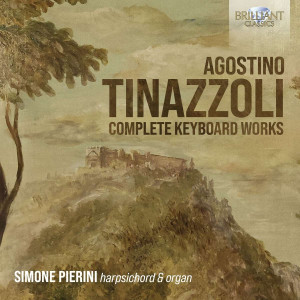Košík
Váš košík je momentálne prázdny.
Tinazzoli: Complete Keyboard Works (2CD)
14,00 €
Formát:
CD
Dostupnosť:
7-14 dní
Katalógové číslo:
96875
EAN kód:
5028421968759
Autori:
Agostino Tinazzoli
Interpreti:
Simone Pierini
Vydavateľ:
BRILLIANT CLASSICS
Zoznam skladieb
CD 1Toccata No. 17
1 I. Allegro
2 II. Grave. Arpeggio – Prestissimo – Adagio
3 III. Affettuoso
Toccata No. 18
4 I. Allegro
5 II. Suo balletto
6 Sonata No. 12: I. Eelevatione. Adagio
Capriccio No. 3
7 I. Presto
8 II. Adagio
9 III. Minuet. Allegro
10 Toccata No. 6: I. Allegro
11 Capriccio No. 16: I. Allegro
12 Capriccio No. 7: I. Allegro
13 Sonata No. 5: I. Offertorio
Capriccio No. 14
14 I. Allegro
15 II. Adagio – Allegro
16 Capriccio No. 9: I. Allegro
17 Capriccio No. 10: I. Allegro
CD 2
1 Sonata No. 13: I. Post agnus. Allegro
Sonata No. 4
2 I. Allegro
3 II. Sarabanda
4 III. Allegro
5 Sonata No. 2: I. Allegro
6 Partite sopra il passagallo
7 Sonata No. 11: I. Offertorio. Allegro
8 Sonata No. 8: I. Allegro
Sonata No. 1
9 I. Adagio
10 II. Allegro
11 III. Largo
12 IV. Prestissimo arpeggiato – Adagio
13 V. Allegro
14 Capriccio No. 15: I. Allegro
Popis
The pieces presented here are ascribed to a composer whose life appears to be both mysterious and adventurous: quite little of Agostino Tinazzoli is known, including biographical details such as his occupations, teachers and places of residence (except for limited, incomplete information). However, some unusual facts preserved through his music illustrate that this composer had no ordinary life. New Grove Dictionary of Music and Musicians informs us that Agostino Tinazzoli was born in Bologna during the second half of the 17th century, quite possibly around 1660. Most of the works attributed to Tinazzoli concern sacred music, including various oratorios (such as Il sacrifizio di Gefte), and masses (such as an incomplete Requiem). This collection of solo keyboard music comes from two manuscripts currently preserved in Münster and Bologna. The former contains all the pieces included in the two CDs, while the latter includes Toccata No.18 and a larger version of the Toccata No.17 including all the movements performed (the Münster manuscript contains only the first movement). Four of the pieces of the collection are specified for the organ, and they are intended to be used during the Mass: there are two Offertorios, one Elevazione and a Post Agnus, and all of them are titled Sonata. Tinazzoli assigns the terms Sonata, Toccata, and Capriccio to these pieces (except for the Passagallo), but there is seemingly no criteria for the choice of name. The collection employs a wide range of styles and formal structures: there are concerto-like pieces (Toccata No.17, Sonata no.4), as well as fugato pieces (Sonata No.11), and dance movements (for example, the Sarabanda in Sonata No.4, or the concluding Minuetto in Capriccio No.3). While we are unable to determine a precise timeframe of composition, it seems that even if the pieces may have been composed in disparate years Tinazzoli remained well informed throughout his career about the stylistic developments occurring in Italy and Europe in his day: the organ pieces, for example, adhere to the late-18th-century style, which was fundamentally more operatic. The most important feature of these pieces, however, is the pervasive employment of basso continuo: the pieces are almost constantly notated in two voices (treble and bass) but with figured bass numerals throughout. In this collection, Pierini has employed basso continuo and improvisation features in the most stylistically appropriate way, considering the wide range of styles included. The pieces presented here are ascribed to a composer whose life appears to be both mysterious and adventurous at the same time: little of Agostino Tinazzoli (ca 1660-1725) is known, as concerns biographical details such as his living places, his teachers, and the job positions he held. However, some unusual facts preserved through his music make clear that this composer probably had no ordinary life: during his stay in Rome he probably committed, or was involved, in an unspecified crime: for this reason, he got incarcerated in Castel Sant’Angelo, Rome, which during Tinazzoli’s time was partly used as a city jail. Here he continued to compose: his cantata “In Carcere penoso” was written with carbon on the prison wall, and its beauty prompted his immediate release from jail. This collection of Tinazzoli’s keyboard music employs a wide range of styles and formal structures: we have concerto-like pieces (Toccata No.17, Sonata no. 4), as well as fugato pieces (Sonata No.11), and dance movements (the Sarabanda in Sonata No.4). The most important feature of these pieces, however, is the massive employment of basso continuo: the pieces are almost everywhere notated in two voices (treble and bass), but continuo numeration is employed everywhere. This means that the performer has to add other voices, or remove them in order to make dynamic effects, and sometimes even to improvise counterpoint, according to stylistic continuo rules in early 18th century’s Italy. Born in Rome in 1996, Simone Pierini began studying music at the age of eight. Aged eighteen, he graduated in piano at S. Cecilia Conservatory of Music, Rome, with highest honors, and consequently took part in masterclasses and post-graduate courses. He afterwards grew interest in historically informed piano practice, attending masterclasses led by Alexei Lubimov, Andreas Staier, Tobias Koch, Stefano Fiuzzi. Subsequently, his interest about historical keyboards in general grew further, and he began studying harpsichord and basso continuo with such teachers as Andrea Coen and Giovanni Togni. He builds an active concert career. Prihlásenie
Newsletter



